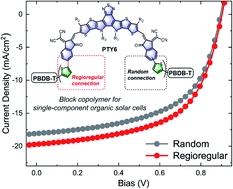Narrow bandgap (NBG) block copolymers are promising materials to realize single-material organic solar cells (SMOSCs) that combine high performance with minimized fabrication procedures. Quite recently, the exploitation of polymerized small molecule acceptors (PSMAs) capable of harvesting infrared photons, in conjunction with visible-light absorbing donor polymers, has been demonstrated as an effective route to design efficient NBG block copolymers. In this work, two NBG copolymers, namely PBDB-T-b-PTY6 and PBDB-T-b-PTY6-γ, were designed and synthesized. By precisely controlling the regiospecificity of the PSMA segment, regioregularity has been successfully achieved over the block copolymer backbone. There are evident differences between the properties of PBDB-T-b-PTY6 and PBDB-T-b-PTY6-γ due to different regioselectivity within the polymer backbone. Specifically, PBDB-T-b-PTY6-γ exhibits increased light absorbance, dominant electron transport properties, and a more ordered solid film structure. Moreover, the regioregular block polymer exhibits an increased short-circuit current density (Jsc) approaching 20 mA cm−2, resulting in an improved power conversion efficiency (PCE) of 10.51% in solar cells, which is among the highest reported for SMOSCs, indicating the important role of regioselectivity in determining block copolymer properties.

